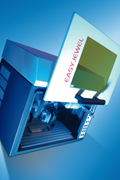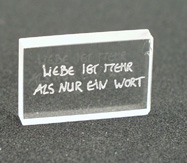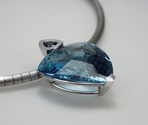15 October 2008
Rofin?s EasyJewel is the Gem in Jewellery Production
 Tobias Teigelkötter presents us with an example of smoked quartz, which has tiny but perfectly legible engraved writing. These letters, only 1 mm high, could not be engraved using conventional techniques. The same is true of the original handwriting on another sample, this one rock crystal.
Tobias Teigelkötter presents us with an example of smoked quartz, which has tiny but perfectly legible engraved writing. These letters, only 1 mm high, could not be engraved using conventional techniques. The same is true of the original handwriting on another sample, this one rock crystal.
 The key to the perfect engraving on these stones is a technology which has been fascinating goldsmiths and jewellery designers alike for more than a decade now - the laser. It is not, however, the well-known and expensive UV laser source, Tobias uses EasyJewel the compact and cost-effective jewellery laser marker, to achieve these perfect results. The EasyJewel is a system specifically designed for marking precious metal, and in the hands of someone such as Tobias, who has so much knowledge about the craftsmanship of stone engraving and laser technology, completely new applications are possible.
The key to the perfect engraving on these stones is a technology which has been fascinating goldsmiths and jewellery designers alike for more than a decade now - the laser. It is not, however, the well-known and expensive UV laser source, Tobias uses EasyJewel the compact and cost-effective jewellery laser marker, to achieve these perfect results. The EasyJewel is a system specifically designed for marking precious metal, and in the hands of someone such as Tobias, who has so much knowledge about the craftsmanship of stone engraving and laser technology, completely new applications are possible.
Three generations of jewellery tradition in Werne
The jewellery designer, together with his wife Christin, are now the 3rd generation of the Teigelkötter family to run the studio. His grandfather Heinrich Teigelkötter, a master watchmaker and master optician, founded the studio in the historic Tudor style house in Werne in 1921. His son Heinz took over the company in 1975 and steadily expanded the range of products to the point where the business outgrew the original house. In the mid Nineties the studio moved to new larger premises close by. Between 1990 and 1994, Tobias Teigelkötter was well on his way to being trained as a goldsmith and shortly afterwards he first encountered the technology which would have a considerable impact on his future professional life.
Pioneering lasers within the jewellery industry
In 1995, Tobias Teigelkötter began working with Hans Schindler in Soest, where at the time, the first manual welding laser from Baasel Lasertech (today ROFIN / Baasel Lasertech) was being tested for jewellery production. It did not take long for Tobias to see the potential of this new tool and he has been involved in the development and use of the system ever since. Fascinated by the potential of manual welding laser techniques, the goldsmith promptly ordered a system for the family-run enterprise in Werne. However, the laser did not stay for long, as Tobias continued his professional training and started to study design of precious stones and jewellery in Idar-Oberstein in 1996 – moving his studio and taking the laser with him.
New kinds of settings achieved using the Rofin manual welding laser
 One example of innovation, made possible by the use of a Rofin manual welding laser, is a new setting technique which can be used on complicated shapes and does not conceal large areas of the stone. With conventional techniques, securing the setting over the girdle can involve heavy mechanical load on the precious stone, and corners of square stones or shapes which have pointed edges are therefore extremely vulnerable to cracking. By comparison, the laser allows filigree welding of the finest materials very close to heat-sensitive precious stones.
One example of innovation, made possible by the use of a Rofin manual welding laser, is a new setting technique which can be used on complicated shapes and does not conceal large areas of the stone. With conventional techniques, securing the setting over the girdle can involve heavy mechanical load on the precious stone, and corners of square stones or shapes which have pointed edges are therefore extremely vulnerable to cracking. By comparison, the laser allows filigree welding of the finest materials very close to heat-sensitive precious stones.
 Using laser welding, new types of settings have been developed to secure the stone between two thin sheets, which have previously been cut for a perfect fit. Having being welded by the laser, the conical edges of the cut fix the Rondiste around the circumference or alternatively, only at selected points, This concept leaves the rear of the stone completely free, allowing completely new filigree and transparent jewellery design, particularly for larger stones. The manual welding laser is not just used for setting stones but also for a wide variety of other applications in jewellery production. The precision of the laser together with the minimal heat input allow the application of claw settings directly onto the stone. Tobias Teigelkötter does all of the fixings prior to soldering. One or two spot welds tack the pieces together, much better than any other joining technique.
Using laser welding, new types of settings have been developed to secure the stone between two thin sheets, which have previously been cut for a perfect fit. Having being welded by the laser, the conical edges of the cut fix the Rondiste around the circumference or alternatively, only at selected points, This concept leaves the rear of the stone completely free, allowing completely new filigree and transparent jewellery design, particularly for larger stones. The manual welding laser is not just used for setting stones but also for a wide variety of other applications in jewellery production. The precision of the laser together with the minimal heat input allow the application of claw settings directly onto the stone. Tobias Teigelkötter does all of the fixings prior to soldering. One or two spot welds tack the pieces together, much better than any other joining technique.
Marking lasers replace traditional engraving methods
Laser marking of jewellery has become an essential part of the success of the Teigelkötter studio. Laser technology provides all of the benefits of contact-free, abrasion-resistant and permanent marking for most materials such as platinum, gold, silver or titanium. Thanks to high speed, ultimate precision and the possibility of deeper engravings, marking lasers have now replaced diamond engraving at numerous jewellery manufacturers and high street jewellers.
However, this was not the case at the beginning of the new millennium. When early users began testing their marking laser systems, the man - machine interface in particular proved to be a restraining factor. Parts could not always be put into position with sufficient accuracy by hand, and furthermore, the adjustment and setting of the system sometimes required extensive programming knowledge of Visual Basic. The high investment costs, initially associated with marking lasers, also impeded the uptake of the technology. However, the introduction of the new low-cost EasyJewel system, specifically designed for jewellery manufacture, brought about a rapid change in the adoption of laser marking technology within the jewellery industry.
Ring marking is the main application
 The classic marking application is surely engraving the inside of rings. Here, the precision of the laser allows the generation of motifs which cannot be achieved using conventional methods. Facsimiles of handwriting in calligraphic quality with different line widths can be reproduced true to the original. Another outstanding characteristic of the laser is efficiency. A standard engraving with a depth of two to three tenths of a millimetre can be completed easily within only a few minutes - including set-up times.
The classic marking application is surely engraving the inside of rings. Here, the precision of the laser allows the generation of motifs which cannot be achieved using conventional methods. Facsimiles of handwriting in calligraphic quality with different line widths can be reproduced true to the original. Another outstanding characteristic of the laser is efficiency. A standard engraving with a depth of two to three tenths of a millimetre can be completed easily within only a few minutes - including set-up times.
These are the distinguishing features which establish the laser as the process with the highest performance when compared to other marking technologies.
It is not only the performance and excellent beam quality, required for efficient and high-quality processing of precious metals, but also the sophisticated all in one solution offered by Rofin’s EasyJewel which has made this system the first choice of many jewellery manufacturers and high street jewellers. A single fixture is used to grip parts either internally or externally, thus providing the capability to produce marks not only on the inside and outside of the part, but also on the faces or edges of the part. Having entered the basic geometry and material parameters, the user can then determine the optimum marking position using the precise jogging feature, and then see a live preview from the on line camera, leaving no doubt about the position or quality of the finished product.
EasyJewel’s sophisticated marking software automatically makes geometric corrections for applications which require a non-perpendicular approach to the marking area. Large marks can easily be achieved with the help of the Auto-tilting function within EasyJewel.
High-Tech in the goldsmith's studio
In the Teigelkötter studio, the marking laser has now been used for a wide range of applications. Hallmarking can be applied without applying any mechanical load at the end of the production process and in the most suitable location. For inlay work or channel setting, the laser ablates the material down to a depth of 0.4 to 0.6 mm - without any corner radius, unavoidable when using rotating milling tools.
The laser does the marking for all bevel settings just as for the two sheets forming the laser welded setting. For this purpose, the stone is scanned, and the contours are verified. These parameters make the inner and outer contour lines for the setting.
Tobias Teigelkötter fills any spare capacity on his marking lasers with job shop orders - often for local shops: e. g. personalizing high-value hunting knives made of specific steel which are difficult to mark with conventional engraving methods. Or he may do some more research work looking for other new and interesting applications for the laser.
- Contact Information
- Name: Mike Batchelor
- Email: sales@rofin-baasel.co.uk

